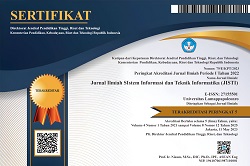Rancang Bangun Chatbot Budaya Berbasis Web Menggunakan Platform No-Code dengan Pendekatan User Centered Design
Abstract
This study addresses the need for user-friendly digital media to introduce Gorontalo’s cultural heritage to youth and tourists. We designed and developed a web-based cultural chatbot prototype (Maleo) using the Smojo platform and a User-Centered Design (UCD) approach. The method followed the UCD cycle: understanding usage context via expectation surveys, specifying functional and nonfunctional requirements, modeling interactions with use case and activity diagrams, implementing a Smojo-based prototype, and evaluating usability using the System Usability Scale (SUS). Data were collected through online questionnaires and limited user testing with local youths and visitors who had experienced Gorontalo. Results indicate a mean SUS score of 80.0 (range 62.5–100; standard deviation ≈ 12.27), placing the prototype in the excellent usability category, with clear navigation, low interaction barriers, and positive intention to reuse. The findings confirm that a UCD-driven, no-code development approach effectively produces an informative, learnable interface for local cultural contexts. Implications include enhancing onboarding, standardizing content and interoperability (via APIs), adopting multi-metric evaluations beyond SUS, and providing stakeholder analytics dashboards to strengthen the educational and promotional impacts of the platform in a sustainable manner.
Downloads
References
Bennett, W. L., Freelon, D. G., Hussain, M. M., & Wells, C. (2012). Digital media and youth engagement. The SAGE Handbook of Political Communication, 127–140.
Chai-Arayalert, S., Sathiyabamavathy, K., Martins, J., colleagues, International Organization for Standardization, Savolainen, K., Indian Institute of Management Kozhikode, Nguyen, M. H., colleagues, Borsci, S., colleagues, Hyzy, M., & colleagues. (2024). Usability, engagement, and usefulness of web-based chatbots. Journal of Computer Languages, 24(6), 126. https://doi.org/10.1080/23311983.2024.2396206
Chandran, L., & Abdulla, M. S. (2022). A survey of Low-Code/No-Code software development tools with an application.
Chang, C.-C., Chang, H.-P., & Lee, H.-S. (2024). Leveraging Retrieval-Augmented Generation for Culturally Inclusive Hakka Chatbots: Design Insights and User Perceptions. 2024 IEEE International Conference on Recent Advances in Systems Science and Engineering (RASSE), 1–6.
Firdaus, M., Thangavelu, N., Ekbal, A., & Bhattacharyya, P. (2022). I enjoy writing and playing, do you?: A personalized and emotion grounded dialogue agent using generative adversarial network. IEEE Transactions on Affective Computing, 14(3), 2127–2138.
Hidayat, A., Nugroho, A., & Nurfa’izin, S. (2022). Usability evaluation on educational chatbot using the system usability scale (SUS). 2022 Seventh International Conference on Informatics and Computing (ICIC), 1–5.
Hidayat, C. R., Sumaryana, Y., Anwar, D. S., Fadilah, A. L. N., & Saputra, M. R. (2025). Pengembangan Virtual Assistant (Chatbot) Bebrbasis NLP (Natural Language Processing) Untuk Portal Informasi Terpadu Pariwisata Tasikmalaya. CSRID (Computer Science Research and Its Development Journal), 17(1), 136–148.
Hyzy, M., Bond, R., Mulvenna, M., Bai, L., Dix, A., Leigh, S., & Hunt, S. (2022). System Usability Scale Benchmarking for Digital Health Apps: Meta-analysis. JMIR MHealth and UHealth, 10(8), e37290. https://doi.org/10.2196/37290
ISO. (2019). INTERNATIONAL STANDARD interactive systems iTeh STANDARD iTeh STANDARD PREVIEW. 2019.
Kurniawan, R., & Putra, D. P. (2022). Perancangan User Interface Sistem Kredit Aktivitas Mahasiswa STMIK “AMIKBANDUNG” Berbasis Website Menggunakan Metode User Centered Design (UCD). Journal of Information Technology, 4(1), 23–30.
Kurniawan, S. (2004). Interaction design: Beyond human–computer interaction by Preece, Sharp and Rogers (2001), ISBN 0471492787. Universal Access in the Information Society, 3(3), 289.
Le, H. (2019). Designing a concept of chatbot mobile application to enhance travel experiences using user-centred approach.
Maguire, M. (2001). Methods to support human-centred design. International Journal of Human-Computer Studies, 55(4), 587–634.
Martins, J., Branco, F., & Mamede, H. (2023). Combining low-code development with ChatGPT to novel no-code approaches: A focus-group study. Intelligent Systems with Applications, 20, 200289. https://doi.org/https://doi.org/10.1016/j.iswa.2023.200289
Mustafina, S. N., Khan, N. K., Islam, M. N., Nusrat, F. S., & Akhtaruzzaman, M. (2025). System Usability and Design Evaluation of AI Chatbots: A Comparative Analysis of ChatGPT, Google Bard, and Bing Chat. MIST INTERNATIONAL JOURNAL OF SCIENCE AND TECHNOLOGY, 13, 83–97.
Nguyen, M. H., Sedoc, J., & Taylor, C. O. (2024). Usability, Engagement, and Report Usefulness of Chatbot-Based Family Health History Data Collection: Mixed Methods Analysis. Journal of Medical Internet Research, 26, e55164. https://doi.org/10.2196/55164
Pricope Vancia, A. P., Băltescu, C. A., Brătucu, G., Tecău, A. S., Chițu, I. B., & Duguleană, L. (2023). Examining the disruptive potential of generation Z tourists on the travel industry in the digital age. Sustainability, 15(11), 8756.
Pu, Z., & Beam, M. A. (2021). Information Overload and User Satisfaction: Balance Between Reliance on Recommendations and Deliberate News Selection. INRA@ RecSys, 47–61.
Sathiyabamavathy, K., & Anju, K. P. (2024). Role of Chatbots in Cultural Heritage Tourism: An Empirical Study on Ancient Forts and Palaces. Journal of Heritage Management, 9(1), 9–28.
Savolainen, K. (2021). User-Centred Design without Involving Users: A Longitudinal Case Study in a Human-Centred-Design–Mature Company. The Design Journal, 24(6), 887–905. https://doi.org/10.1080/14606925.2021.1980267
Sidorenko-Bautista, P., Herranz de la Casa, J. M., & Cantero de Julián, J. I. (2020). Use of New Narratives for COVID-19 reporting: from 360o videos to ephemeral TikTok videos in online media.
Siliutina, I., Tytar, O., Barbash, M., Petrenko, N., & Yepyk, L. (2024). Cultural preservation and digital heritage: challenges and opportunities. Amazonia Investiga, 13(75), 262–273.
Tong, S. T., Corriero, E. F., Matheny, R. G., & Hancock, J. T. (2018). Online Daters’ Willingness to Use Recommender Technology for Mate Selection Decisions. IntRS@ RecSys, 45–52.
Upadhyaya, N. (2023). Low-Code/No-Code platforms and their impact on traditional software development: A literature review. No-Code Platforms and Their Impact on Traditional Software Development: A Literature Review (March 21, 2023).
Xu, Y., Zhang, J., & Deng, G. (2022). Enhancing customer satisfaction with chatbots: The influence of communication styles and consumer attachment anxiety. Frontiers in Psychology, 13, 902782.
JISTI
















